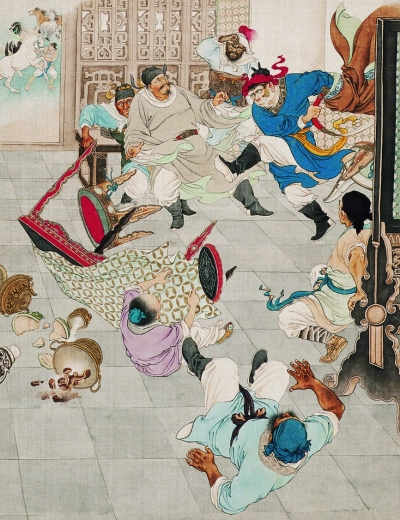Rich monkey symbolism captured in art

One painting in the series Havoc in Heaven tells the story of how Sun Wukong discovered that Heaven gave him the lowest job to subdue him and was excluded from a royal banquet that included every other important god and goddess. This prompted him to rebel against Heaven. The story is seen by many as a celebration of freedom, talent and mischievous joy in defiance against hierarchy and authority.
Each animal of the Chinese zodiac has unique characteristics or connotations that make it appealing. For example, the monkey is reputed to be agile and clever. It is also believed to be an auspicious animal because in Chinese, the word for monkey is a homophone for the title of a nobleman ranked below a duke but above an earl at court.
A number of works of fine art have been created that draw on these connotations. One example is the painted clay sculpture Monkey and Horse, which originated in Fengxiang County, Shaanxi Province and is stored at the National Art Museum of China (NAMOC).
It depicts a monkey sitting on the back of a horse. Mashang, literally “on the horse,” is an idiom meaning “right away” in Chinese. The whole work symbolizes the rapid promotion of a noble through the hierarchy.
In addition to being seen as agile and smart, monkeys are also believed to be wild and rebellious. Other tales have them acting naive and adorable, while some portray them as naughty and stubborn. In legends, they are powerful and possess marvelous abilities. The most famous of these is Sun Wukong, known as the Monkey King in the West, the main character in the classical Chinese epic novel Journey to the West.
The Monkey King is frequently the leading role in shows and operas. His defiance against the heavenly court and dignitaries, and the the way he pokes fun at his opponents, make him an audience favorite.
The series of paintings collectively titled Havoc in Heaven are the representative works of talented modern Chinese artist Liu Jiyou (1918- 1983). In one of the paintings, the Monkey King is handsome and tall, with a straight-backed posture. Through its pleasing balance of compact composition and smooth lines, as well as rich colors and its depiction of astute facial expressions, the whole painting creates a powerful and unconventional mythical and heroic image, showing the skillful technique of the painter.
Toys with the image of monkeys are also a unique and fascinating form of folk art. In China, folk toys are rich in cultural connotations and express folk customs. In 2013, in an exhibition of folk toys NAMOC held in Russia, over 800 toys were selected from more than 60,000 items. Among them, the Monkey King is depicted as a lively and amusing monkey.
Another reason why people have an affection for monkeys is that the animal represents longevity. In folk legends, the Monkey King tore up pages recording the death of the monkey – effectively erasing his obituary in the netherworld. Hence, the netherworld had no control of the longevity of all monkeys. Similarly, the peach is also said to have longevity. According to Chinese folk legends, peaches that ripen after 3,000 years can grant immortality to humans who consume them. That is why the two things are often combined together in artistic works to represent longevity. For example, in the scroll of Monkey with Longevity Peach by Qi Baishi (1863-1957), the image of a happy monkey holding a longevity peach, symbolizes long life with fortune.
Han Jinsong is an associate researcher at the National Art Museum of China.
